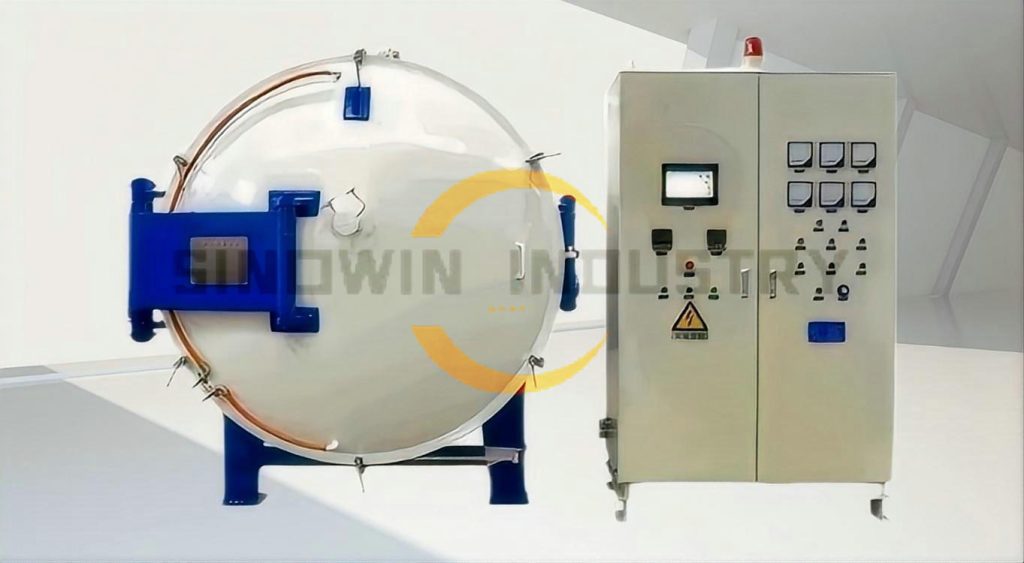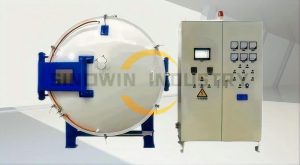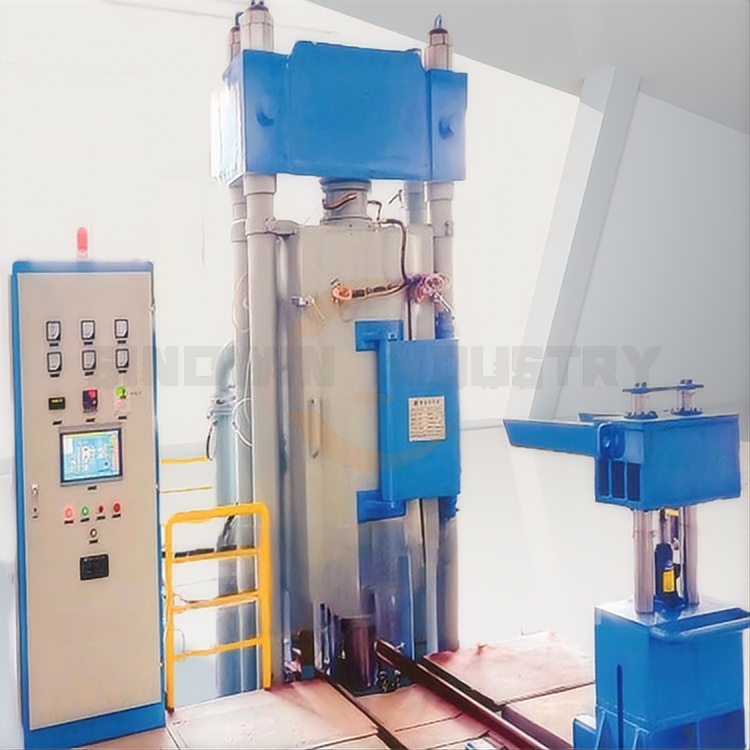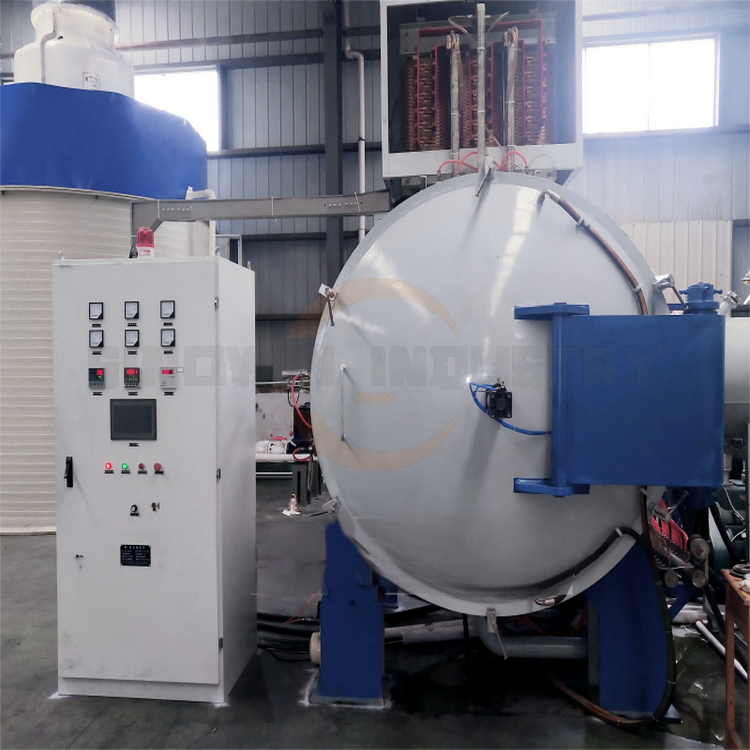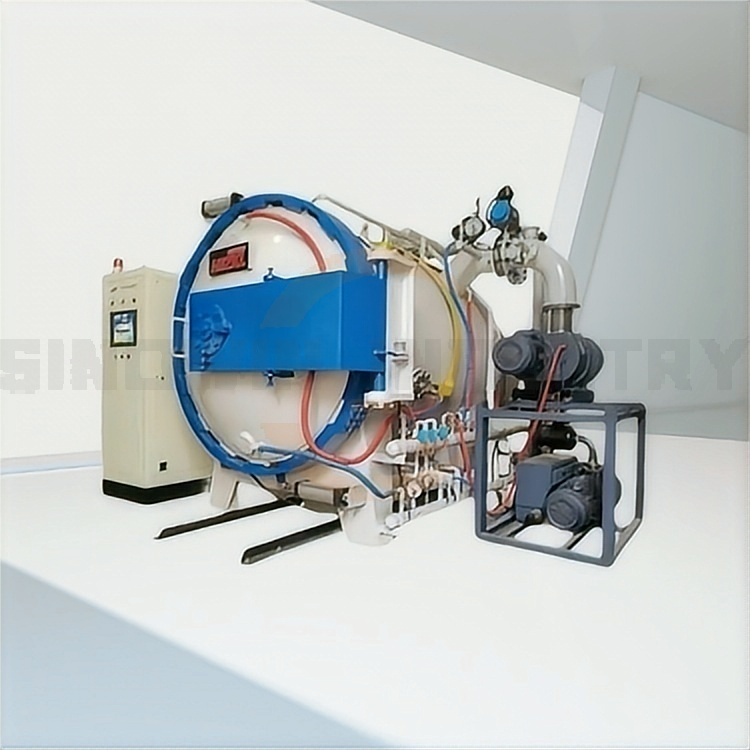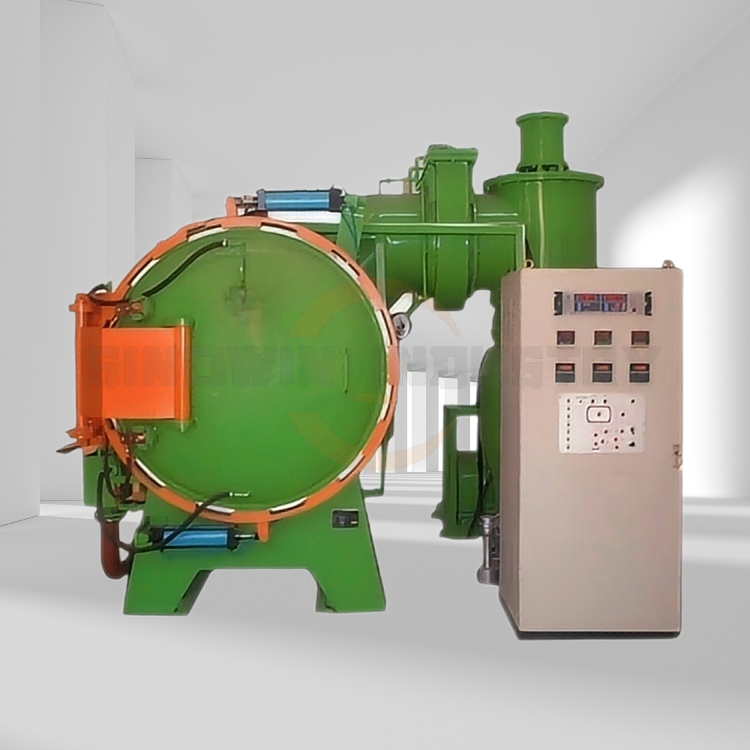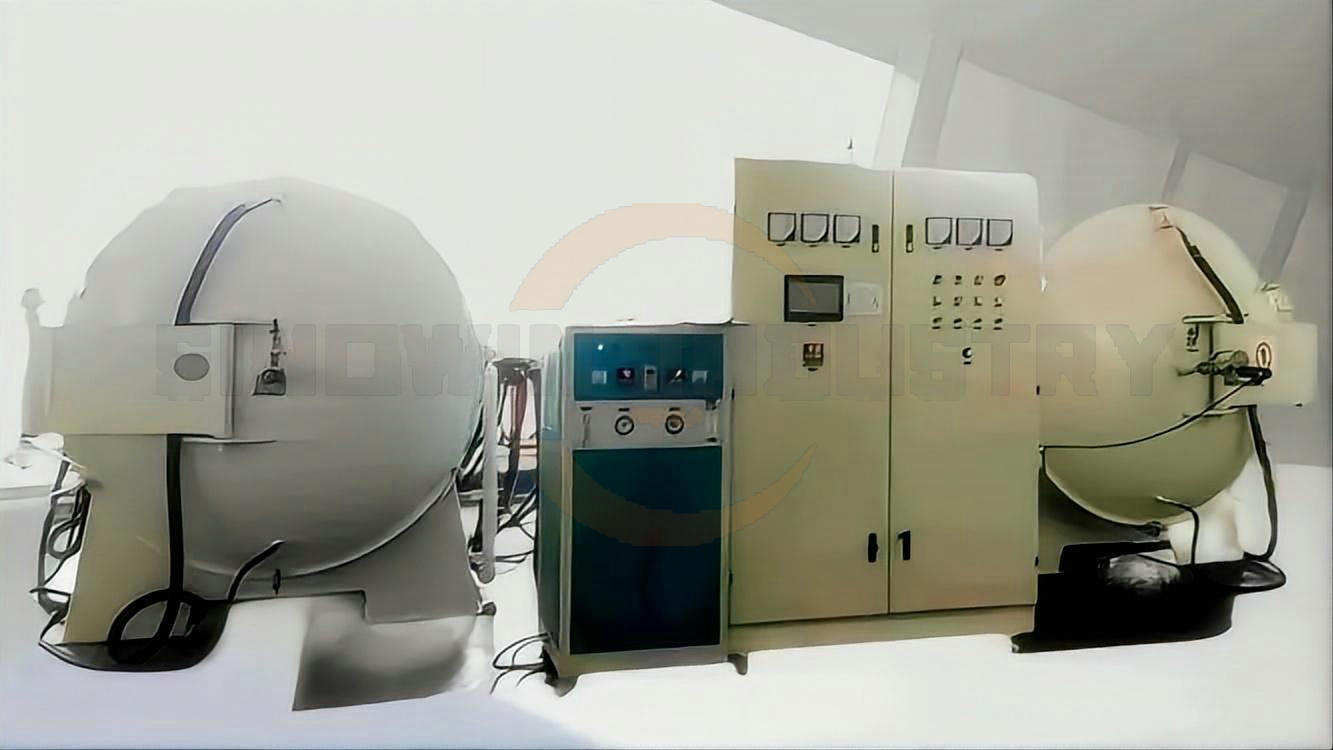Product Description:
The High Temeprature Vacuum Sintering Furnace for Lithium-ion Batteries is a specialized furnace designed for protective sintering of heated materials in a vacuum environment. It utilizes various heating methods, including resistive heating, induction heating, and microwave heating. This furnace operates primarily with induction heating, distinguishing itself into subcategories based on frequency: low, medium, and high frequency.
Key Features of Industrial Vacuum Sintering Furnace:
- High operational stability with temperature capabilities reaching up to 2500°C.
- Exceptional temperature uniformity under high temperatures, making it ideal for demanding applications such as high-performance ceramics and powder metallurgy that require precise dimensional shrinkage and product density.
- Integrates debinding and sintering processes into a single operation, significantly reducing production cycles. The furnace is equipped with a screw pump unit or rotary vane pump unit that features automatic cleaning capabilities.
Applications:
Our Vacuum Sintering Furnace is versatile and is suitable for a broad range of applications, including:
- Uniaxial sintering of boron carbide ceramics
- Uniaxial sintering of silicon carbide ceramics
- Heavy recrystallization of silicon carbide ceramics
- Sintering of aluminum nitride ceramics
- Sintering of high-performance ceramic substrates
- Precision ceramic sintering with strict requirements on shrinkage dimensions and consistency in density
- Powder metallurgy sintering, as well as high-temperature vacuum sintering of other metals and non-metal materials.
Product Advantages:
- High Automation Level: The furnace operates with one-click vacuum substitution and argon gas flushing, ensuring automated monitoring of water, electricity, and gas throughout the process. A user-friendly touchscreen interface allows real-time observation of operating status, alarm indications, temperature curves, and control of power on/off operations.
- Durable and Reliable Construction: The furnace body is constructed entirely from 304 stainless steel, built according to pressure vessel standards, ensuring excellent corrosion resistance and sealing performance. The insulation materials utilized are high-purity graphite felt, ensuring longevity. All electrical components are sourced from reliable domestic and international brands, guaranteeing dependable operation.
- Enhanced Safety Features: The furnace incorporates automatic explosion-proof valves and real-time monitoring through a flow switch for the cooling water supply. The power system is strictly designed to set thresholds for overcurrent and overvoltage, enhancing operational safety.
- Optional Features: The Vacuum Sintering Furnace can be equipped with a specialized cooling system for medium-frequency power supply and a gas purification device. The cooling system minimizes equipment failures due to water quality issues, supporting sustained safe operations, while the purification device enhances gas purity, extending the lifespan of the internal insulation materials and reducing overall costs.
- Integrated Sintering Process: All models of the high-temperature vacuum sintering furnace are capable of combining wax removal and sintering into one streamlined process, significantly shortening product lifecycle times.
- Remote Monitoring Capabilities: The integrated monitoring interface allows remote access via PC, enabling managers to observe operational status and retrieve logs and process parameters at any time.
- Comprehensive After-Sales Support: Our dedicated customer service team ensures that users can operate the equipment with complete peace of mind, knowing that support is readily available throughout the operational lifespan of the product.
Technical Parameter of the High Temeprature Vacuum Sintering Furnace for Lithium-ion Batteries
| Work Size | m | 300*300*400 | 450*450*750 | 500*500*1200 | 500*500*1500 | 600*600*2000 | 750*750*2000 |
| Heating Method | / | Resistance Heating/IGBT Heating | |||||
| Ultra Vacuum | Pa | 6.6X10ˉ3 | |||||
| Working Temperature | ℃ | 2400 | 2400 | 2400 | 2400 | 2400 | 2400 |
| Max.Temperature | ℃ | 250 0 | 2500 | 2500 | 2500 | 2500 | 2500 |
| Atmosphere | / | High Vacuum/Vacuum (optional )N²、Ar etc.0 | |||||
Q&As for Sinowin industry’s High temperature Vacuum Sintering Furnace :
Q1: What is a vacuum sintering furnace and how does it work?
A1: A vacuum sintering furnace is a specialized piece of equipment designed for sintering materials in a vacuum environment. The furnace creates a controlled low-pressure atmosphere that prevents oxidation and contamination of the materials being processed. It works by heating the materials to a specific temperature where solid-state diffusion occurs, allowing particles to bond together without melting, enhancing the material’s density and mechanical properties.
Q2: What are the benefits of using a vacuum sintering furnace?
A2: Using a vacuum sintering furnace offers numerous benefits, including the prevention of oxidation and contamination, improved density and mechanical properties of the final product, and the ability to process sensitive materials. Additionally, it allows for the creation of high-purity components and enables sintering of complex shapes that may not be achievable with traditional methods.
Q3: How does vacuum sintering compare to other sintering methods?
A3: Vacuum sintering differs from other methods by maintaining a low-pressure environment that eliminates atmospheric gases, which can adversely affect material quality. Compared to conventional sintering methods, vacuum sintering results in enhanced material properties, reduced porosity, and greater control over the sintering process, making it ideal for high-performance applications.
Q4: What materials can be processed in a vacuum sintering furnace?
A4: A vacuum sintering furnace can process a wide range of materials, including ceramics, metal alloys, composites, and refractory materials. It is particularly suitable for materials that require high purity and have stringent performance requirements, such as aerospace components, medical devices, and advanced engineering materials.
Q5: What factors affect the performance of a vacuum sintering furnace?
A5: Several factors can influence the performance of a vacuum sintering furnace, including the sintering temperature, heating rate, vacuum level, dwell time, and the properties of the materials being sintered. Proper calibration and monitoring of these parameters are crucial for achieving optimal sintering results and material properties.
Q6: How do I safely operate a vacuum sintering furnace?
A6: To safely operate a vacuum sintering furnace, users should follow proper safety protocols, including wearing appropriate personal protective equipment (PPE), ensuring the workspace is well-ventilated, and familiarizing themselves with the furnace’s operating manual. Regular maintenance and inspections are also essential to prevent malfunctions and ensure safe operation throughout its use.
Q7: What are the common industrial applications of vacuum sintering?
A7: Vacuum sintering is commonly used in various industries, including aerospace, automotive, electronics, and biomedical applications. It is used for producing high-performance components, such as turbine blades, precision gears, dental implants, and electronic substrates, where high material integrity and performance are critical.
Q8: How can I improve the efficiency of the vacuum sintering process?
A8: To enhance the efficiency of the vacuum sintering process, consider optimizing the heating profile, minimizing the time required to reach sintering temperature, and ensuring that the vacuum level is consistently maintained. Additionally, pre-conditioning the materials and utilizing advanced monitoring systems can help streamline the process and improve overall quality.
Q9: What troubleshooting tips do you have for vacuum sintering furnace issues?
A9: If you encounter problems with your vacuum sintering furnace, start by checking the vacuum seals and connections for leaks. Ensure that the heating elements are functioning correctly, and analyze the furnace’s temperature control system for accuracy. Regular calibration, preventive maintenance, and consulting the manufacturer’s troubleshooting guide can also aid in resolving common issues.
Q10: Where can I find reliable vacuum sintering furnace manufacturers?
A10: To find reputable vacuum sintering furnace manufacturers, you can start by searching online marketplaces and industry directories. Additionally, attending trade shows and industry conferences can provide direct access to manufacturers. Reading customer reviews, testimonials, and seeking recommendations from industry peers can also help identify trustworthy suppliers with proven track records.Whether you are in research, analysis, or manufacturing, the vacuum sintering furnace supplied from SINOWIN INDUSTRY is your best choice.Donot hesitate to Contact us today for a quote and transform your scientific journey completely.
Technical Parameter of the High Temeprature Vacuum Sintering Furnace for Lithium-ion Batteries
| Work Size | m | 300*300*400 | 450*450*750 | 500*500*1200 | 500*500*1500 | 600*600*2000 | 750*750*2000 |
| Heating Method | / | Resistance Heating/IGBT Heating | |||||
| Ultra Vacuum | Pa | 6.6X10ˉ3 | |||||
| Working Temperature | ℃ | 2400 | 2400 | 2400 | 2400 | 2400 | 2400 |
| Max.Temperature | ℃ | 250 0 | 2500 | 2500 | 2500 | 2500 | 2500 |
| Atmosphere | / | High Vacuum/Vacuum (optional )N²、Ar etc.0 | |||||
